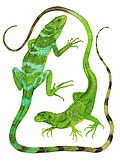Ctenosaura quinquecarinata
| Ctenosaura quinquecarinata | |
|---|---|

| |
| Scientific classification | |
| Domain: | Eukaryota |
| Kingdom: | Animalia |
| Phylum: | Chordata |
| Class: | Reptilia |
| Order: | Squamata |
| Suborder: | Iguania |
| Family: | Iguanidae |
| Genus: | Ctenosaura |
| Species: | C. quinquecarinata
|
| Binomial name | |
| Ctenosaura quinquecarinata | |
| Synonyms | |
Ctenosaura quinquecarinata, commonly known as the Oaxacan spinytail iguana or the five-keeled spiny-tailed iguana is a species of lizard in the family Iguanidae native to Central America.
Geographic range
[edit]It is found in Costa Rica and Nicaragua.[1] Other sources list it also from Mexico and El Salvador.[4]
Habitat
[edit]Its natural habitat is tropical dry forests.[1]
Conservation status
[edit]It is threatened in its native range by habitat loss.[1]
Taxonomy and etymology
[edit]Ctenosaura quinquecarinata was first described by zoologist John Edward Gray in 1842 as Cyclura quinquecarinata; 32 years later it was redesignated by Marie Firmin Bocourt as Ctenosaura quinquecarinata. The generic name, Ctenosaura, is derived from two Greek words: ctenos (Κτενός), meaning "comb" (referring to the comblike spines on the lizard's back and tail), and saura (σαύρα), meaning "lizard".[5] Its specific name quinquecarinata is a combination of two Latin words: quinque meaning "five" and carinata meaning "keeled" and refers to the five rows of scales on the animal's tail.
Description
[edit]The tail on this species is heavily armored with five rings of spines forming longitudinal ridges. Males of the species grow to a length of 35 centimeters (14 in) whereas females attain 18.5 centimeters (7.3 in). Like most Ctenosaura the iguanas are born a bright green color fading to brown as the animal ages. The females tend to turn a uniform drab brown in color, and males develop tones of black, blue and yellow on their bodies and heads over the brown background.
Threats
[edit]Total population size is not known, but it is estimated that there may be fewer than 2,500 mature individuals.[1] It is threatened by habitat loss through deforestation, overcollection through an unregulated exploitation for the pet trade,[1] and it is even hunted by humans as a food item.
References
[edit]- ^ a b c d e f Reynoso, V.H.; Ubeda, M.; Vázquez-Cruz, M.; Rivera-Arroyo, R.C.; Malone, C.L.; Grant, T.D. (2020). "Ctenosaura quinquecarinata". IUCN Red List of Threatened Species. 2020: e.T44193A2993977. doi:10.2305/IUCN.UK.2020-2.RLTS.T44193A2993977.en. Retrieved 16 November 2021.
- ^ "Appendices | CITES". cites.org. Retrieved 14 January 2022.
- ^ "Ctenosaura quinquecarinata". Integrated Taxonomic Information System. Retrieved 2 January 2008.
- ^ a b Ctenosaura quinquecarinata at the Reptarium.cz Reptile Database. Accessed 13 November 2015.
- ^ Malfatti, Mark (2007). "A look at the genus Ctenosaura: meet the world's fastest lizard and its kin". Reptiles Magazine. 15 (11): 64–73.
Further reading
[edit]- Gray, J.E. 1842. Description of some new species of Reptiles, chiefly from the British Museum collection. Zoological Miscellany 57–59. (Cyclura quinquecarinata, p. 59.)


